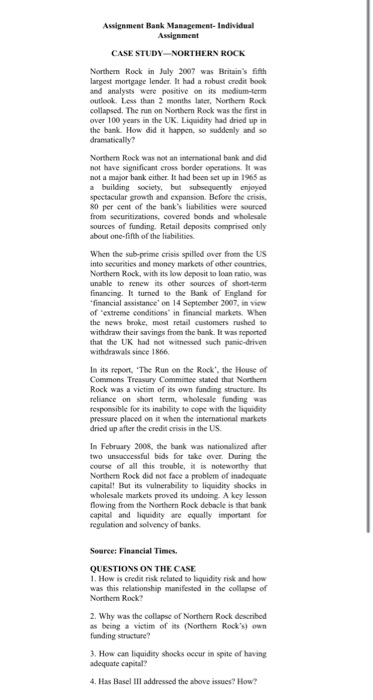Assignment Bank Management-Individual Assignment CASE STUDY-NORTHERN ROCK Northern Rock in July 2007 was Britain's fifth largest mortgage lender. It had a robust credit book and analysts were positive on its medium-term outlook Less than 2 months later, Northern Rock collapsed. The run on Northern Rock was the first in over 100 years in the UK. Liquidity had dried up in the bank. How did it happen, se suddenly and so dramatically? Northern Rock was not an international bank and did not have significant cross border operations. It was not a major bank either. It had been set up in 1965 as a building society, but subsequently enjoyed spectacular growth and expansion. Before the crisis 80 per cent of the bank's liabilities were sourced from securitizations, covered bonds and wholesale sources of funding. Retail deposits comprised only about one-fifth of the liabilities When the sub-prime crisis spilled over from the US into securities and money markets of other countries. Northern Rock, with its low deposit to loan ratio, was unable to renew its other sources of short-term financing. It turned to the Bank of England for financial assistance on 14 September 2007, in view of 'extreme conditions in financial markets. When the news broke, most retail customers rushed to withdraw their savings from the bank. It was reported that the UK had not witnessed such panic-driven withdrawals since 1866 In its report, 'The Run on the Rock, the House of Commons Treasury Committee stated that Northern Rock was a victim of its own funding structure. Its reliance on short term, wholesale funding was responsible for its inability to cope with the liquidity pressure placed on it when the international markets dried up after the credit crisis in the US In February 2008, the bank was nationalized after two unsuccessful bids for take over. During the course of all this trouble, it is noteworthy that Northern Rock did not face a problem of inadequate capital! But its vulnerability to liquidity shocks in wholesale markets proved its undoing. A key lesson flowing from the Northern Rock debacle is that bank capital and liquidity we equally important for regulation and solvency of banks Source: Financial Times. QUESTIONS ON THE CASE 1. How is credit risk related to liquidity risk and how was this relationship manifested in the collapse of Northern Rock? 2. Why was the collapse of Northern Rock described as being a victim of its (Northern Rock's) own funding structure? 3. How can liquidity shocks occur in spite of having adequate capital? 4. Has Basel III addressed the above issues? How? Assignment Bank Management-Individual Assignment CASE STUDY-NORTHERN ROCK Northern Rock in July 2007 was Britain's fifth largest mortgage lender. It had a robust credit book and analysts were positive on its medium-term outlook Less than 2 months later, Northern Rock collapsed. The run on Northern Rock was the first in over 100 years in the UK. Liquidity had dried up in the bank. How did it happen, se suddenly and so dramatically? Northern Rock was not an international bank and did not have significant cross border operations. It was not a major bank either. It had been set up in 1965 as a building society, but subsequently enjoyed spectacular growth and expansion. Before the crisis 80 per cent of the bank's liabilities were sourced from securitizations, covered bonds and wholesale sources of funding. Retail deposits comprised only about one-fifth of the liabilities When the sub-prime crisis spilled over from the US into securities and money markets of other countries. Northern Rock, with its low deposit to loan ratio, was unable to renew its other sources of short-term financing. It turned to the Bank of England for financial assistance on 14 September 2007, in view of 'extreme conditions in financial markets. When the news broke, most retail customers rushed to withdraw their savings from the bank. It was reported that the UK had not witnessed such panic-driven withdrawals since 1866 In its report, 'The Run on the Rock, the House of Commons Treasury Committee stated that Northern Rock was a victim of its own funding structure. Its reliance on short term, wholesale funding was responsible for its inability to cope with the liquidity pressure placed on it when the international markets dried up after the credit crisis in the US In February 2008, the bank was nationalized after two unsuccessful bids for take over. During the course of all this trouble, it is noteworthy that Northern Rock did not face a problem of inadequate capital! But its vulnerability to liquidity shocks in wholesale markets proved its undoing. A key lesson flowing from the Northern Rock debacle is that bank capital and liquidity we equally important for regulation and solvency of banks Source: Financial Times. QUESTIONS ON THE CASE 1. How is credit risk related to liquidity risk and how was this relationship manifested in the collapse of Northern Rock? 2. Why was the collapse of Northern Rock described as being a victim of its (Northern Rock's) own funding structure? 3. How can liquidity shocks occur in spite of having adequate capital? 4. Has Basel III addressed the above issues? How







